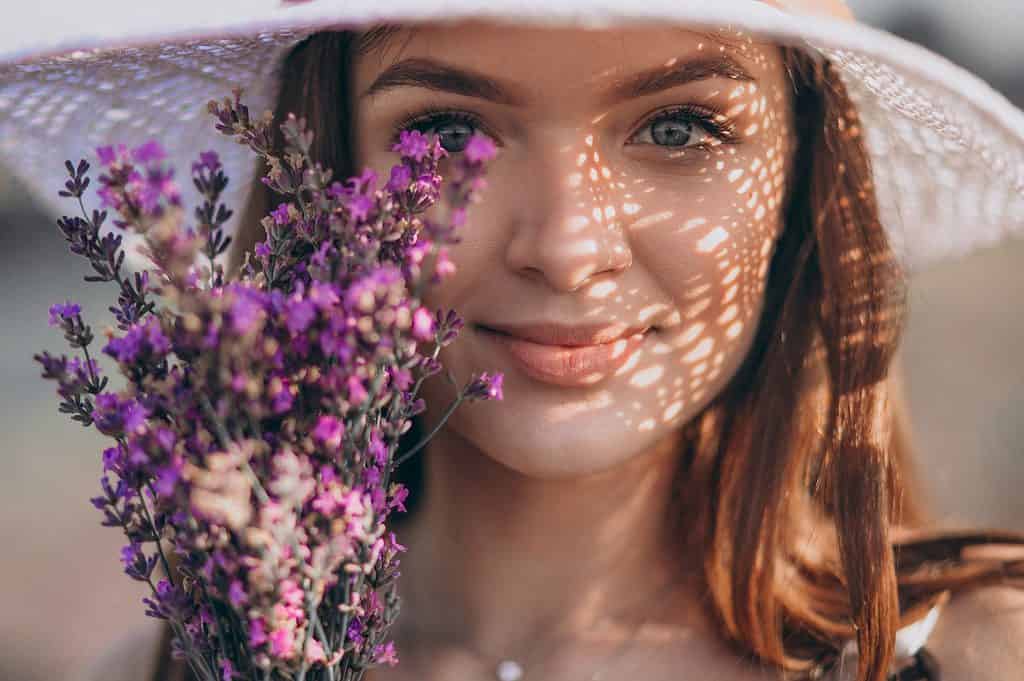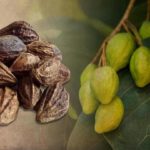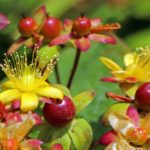
Angelika Klotz
(Holistic therapist)
Most of us are familiar with the relaxing effects of lavender because of the widely sold sachets and aromatised wheat packs that should help us to relax and fall asleep faster.
Apart from its relaxing effects, lavender is one of the most versatile essential oils ever produced. Research has shown that lavender can assist with
- skin healing
- pain
- infections
- blood pressure
- warding off insects
- releasing nervous tension
- headaches and migraines
- sleep
- nausea and calming the digestive system
For more details on lavender, its uses and benefits, we suggest putting a few minutes aside to enjoy reading this article.
Introduction
A few years ago, I visited a lavender farm in Provence, France where they were in the process of distilling the freshly cut plants. To this day, I remember how the workers were having a midday nap on the piles of lavender.

The relaxing fragrance that was hanging in the air eased them into sleep after a hard morning of unloading trucks, filling the large distillation stills and emptying them after the distillation process was completed. It all just looked perfect.
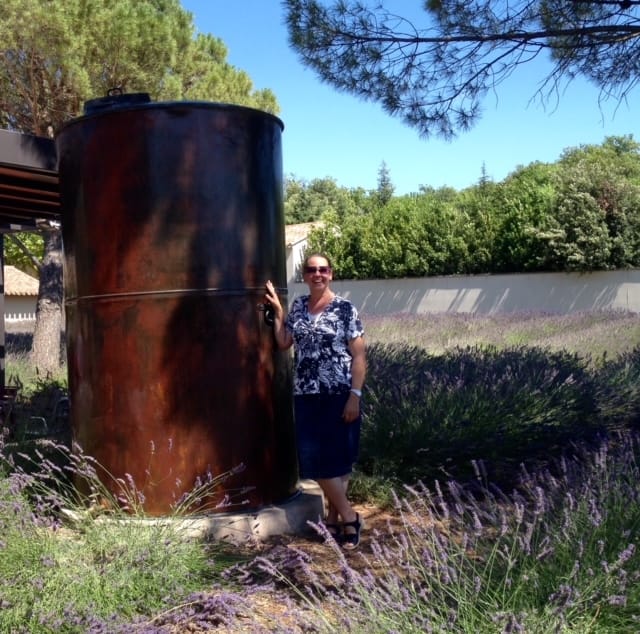
Lavender is a woody evergreen shrub up to 1 m tall, with grey-green narrow linear leaves and blue, purple, violet, pink and even white flowers.
Common name: True Lavender.
Botanical name: Lavandula officinalis, Lavandula angustifolia, Lavandula vera.
It is important to note that lavandula vera is referred to as wild lavender, and it is the same species as the other two, but Lavandula angustifolia is grown at higher altitudes, and has a finer scent and a higher content of ester.
Family name: Lamiaceae.
Extraction methods: Steam distillation.
Parts used: Flower stalks.
Countries: Lavender is indigenous to the mountainous areas of the Mediterranean region.
The best therapeutic true lavender comes from the southeast of France (elevations of 700 metres and above) between the Alps and the Mediterranean Sea.
Lavender grows best in poor, well-drained soils. Other major producers of lavender essential oils are Bulgaria, Croatia, and Russia.
Colour: Colourless to pale yellow.
Odour/smell: Light and sweet floral, herbaceous scent with a balsamic and woody undertone.
Properties: Analgesic, anti-microbial, anti-depressant, anti-rheumatic, antiseptic, antispasmodic, antitoxic, balancing, calming, carminative, cleansing, choleretic (supports the liver and its many functions), cytophylactic (increases white blood cells to fight off infections), deodorant, diuretic, emmenagogue (stimulating menstrual blood flow), hypotensor (lowers blood pressure), insecticide, nervine, parasiticide, purifying, restorative, sedative, stimulant, tonic, vermifuge (destroying intestinal worms).[1]
Chemical composition: The major constituents of lavender are esters and alcohols which can be stimulating or relaxing.
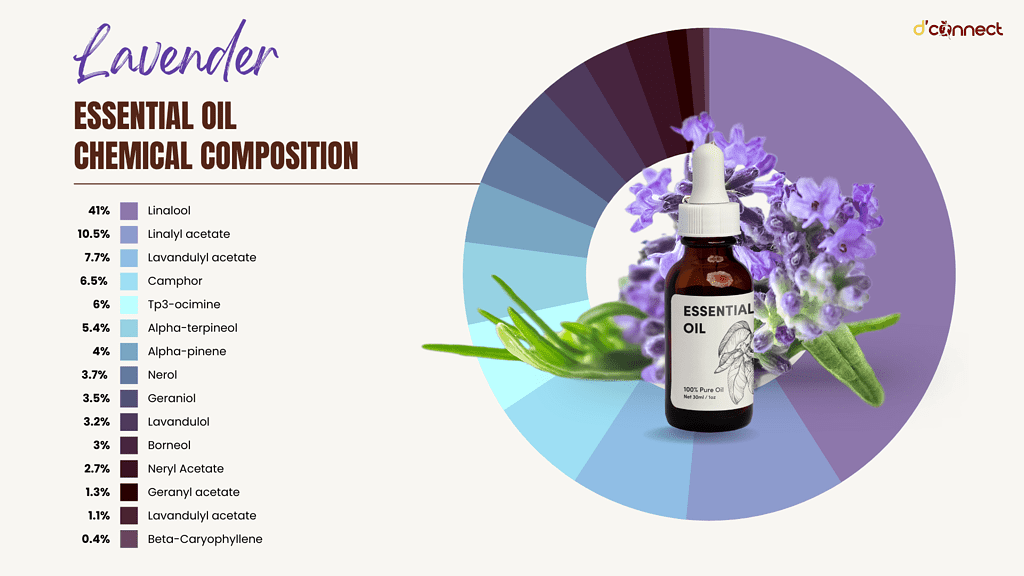
Most commercially traded lavender comes from various growing regions, blended with sub-varieties which leads to significant chemical variations.[2] Chemical constituents vary with growing conditions and locations.
Traditional uses
The name lavender comes from the latin word ”lavere” which means ”to wash”. Since antiquity, lavender has been known as the “nose herb”, prized for its fresh, soft fragrance.
In ancient Greece, Deoscorides (Greek physician 40 – 90 A.D.) recommended it for irritation of the thorax. He also used it to relieve indigestion, sore throats, and headaches.[3]
In ancient Rome, lavender was used extensively in baths for its relaxing and antiseptic effects. It was also used for washing clothes because it had a whitening effect, and was used as a cooking oil.
In ancient Egypt, lavender was used for mummification and perfume. It was found in Tutankhamun’s tomb and it is rumoured that Cleopatra used it to seduce Julius Caesar and Mark Antony.
In medieval Europe, Charles VI of France insisted that his pillow always contained lavender so he could have a good night’s sleep, while in the 16th century English herbalist John Parkinson wrote that lavender was “especially good for all grieves and pains of the head and brain”.
In Traditional Chinese Medicine, it is believed that the Qi of the heart is soothed and supported with lavender which helps with palpitations and high blood pressure. It also cools the Shen (mind) which is ideal for nervous tension and insomnia.[3]
It is often said that modern aromatherapy was born in July 1910 when French chemist Rene-Maurice Gattefosse had an accident in his laboratory burning his hand. With no other liquid around to cool his burn he put his hand immediately in a pot of lavender oil.
After a week of frequent use, there were no blisters or scarring. He noted down the progress and published it in the first ever aromatherapy book prepared for the wider masses.
RELATED — Aromatherapy: What is it and does it really work?
This prompted doctors during WWII to use lavender to heal wounds.
At the same time, French biochemist Marguerite Maury developed a unique method of applying essential oils on the skin through massage which was the start of aromatherapy massage.
Therapeutic uses
Lavender is an exceptionally versatile oil and is used for multiple health issues. The benefits stretch from physical symptoms to mental health issues.
Lavender can help with stress
Lavender has a calming action as well as a stimulating effect, and with that can be balancing and harmonizing.[4]
Lavender and its effect on quality of sleep
A study focusing on 79 college students and effects of inhaled lavender on sleep hygiene, recorded that subjects in the test group reported better and longer sleep as well as waking up more refreshed.[5]
RELATED — Different types of sleep: Which one do we need the most?
With 25-65% of children, adolescents and adults having sleep issues that increase the possibilities of long term illnesses like
- hypertension
- obesity
- depression
- diabetes
this study showed that lavender can achieve improvement in sleep quality.
RELATED — Diabetes: Early Signs, Causes, Types and Treatment
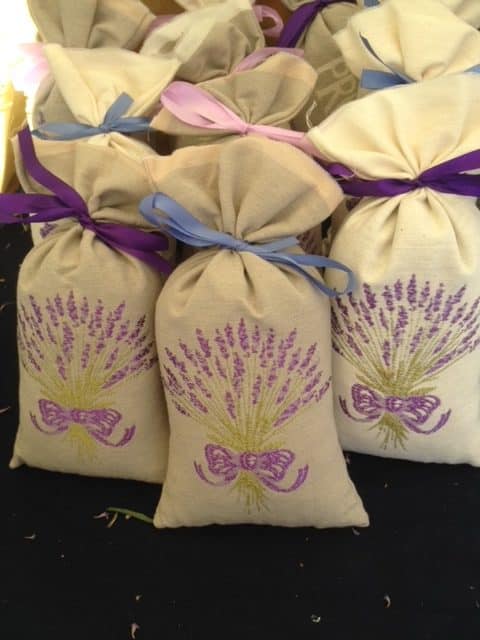
A worthy share here would be the result one of my colleagues had with a client, as she recommended using lavender for sleep issues.
The individual placed lavender sachets to his wrists and the soles of his feet, and within a few evenings he was able to feel more calm and reported falling asleep faster.
Also, when this client went for a check-up a month after his lavender treatment started, the doctor reported that his blood pressure had come down to normal range.
Lavender and the nervous system
Easing nervous tension is one of the main functions of lavender. It can be used for feelings of panic and hysteria since it calms any strong emotions that threaten to overwhelm the mind.
A Japanese study on mice showed that the odour of linalool (a terpene alcohol in lavender extracts) has anti-anxiety effects, but does not cause motor impairment, unlike pharmaceutical drugs based on benzodiazepines which can cause addiction.[6]
Lavender and skin health and healing
Lavender is well known for its amazing skin healing properties when it comes to heat / burn damage.
A study done on rats where lavender was applied every second day to the wounds showed an increased synthesis of collagen and number of fibroblasts which enhanced wound contraction and healing.[7]
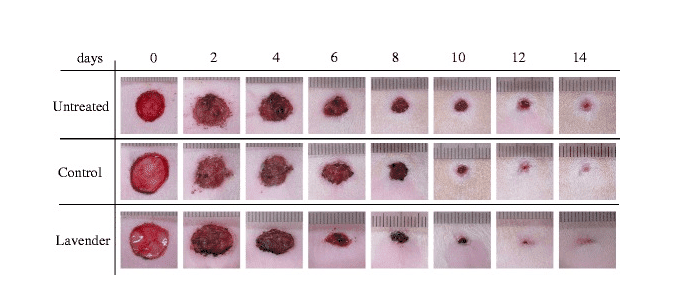
Source: Mori, H. Wound healing potential of lavender oil by acceleration of granulation and wound contraction through induction of TGF-β in a rat model. (2016)
From personal experience in our family, my daughter, who is a passionate cook, has a bottle of lavender in her kitchen and she uses it frequently. So far, she has never had a scar from her accidents and most times burns don’t even result in blisters.
Lavender is one essential oil that can be applied on the skin without being diluted. In the case of burns, cool the wound under cold running water first and then apply lavender oil directly on the burn. The soothing effect is felt immediately.
When added to cream, gel or a mild base, it can be used to treat inflammatory skin conditions like
- dermatitis
- psoriasis
- herpes
- eczema

Source: Rai, V. Anti-psoriatic effect of Lavandula angustifolia essential oil and its major components linalool and linalyl acetate. (2020)
Also, diffusions with lavender can help to ward off insects. Sprays on the skin can help with that as well.
Lavender and its uses for gastrointestinal system
Lavender has analgesic and antispasmodic benefits which helps with diverse symptoms like
- colics
- premenstrual tension and menstrual pain
- muscular stiffness and aching
- irritable bowel syndrome
Irritable bowel syndrome (IBS) is a gastrointestinal disorder that often displays alteration of the intestinal microbiome or dysbiosis, infection of the gastrointestinal tract or bacterial overgrowth in the small intestine. The most popular approach to deal with IBS are antibiotics.
In one particular study they tested essential oils for the antibiotic properties in vitro when they used infused discs in liquid cultures. Scientists found a strong antibiotic activity against E. coli bacteria, which can be very helpful with IBS.[8]
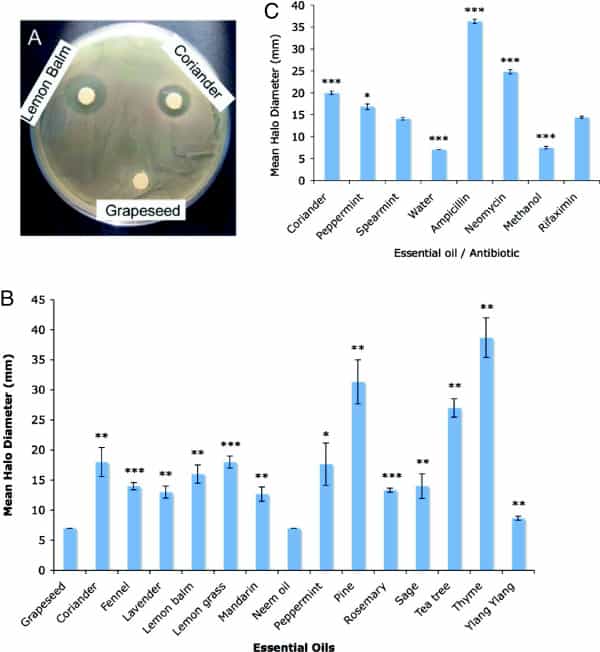
Source: Thompson, A. Comparison of the antibacterial activity of essential oils and extracts of medicinal and culinary herbs to investigate potential new treatments for irritable bowel syndrome. (2013)
Lavender and effects on cardiovascular and lymphatic system
Being a cardiac tonic, lavender lowers or balances high blood pressure. It also acts as a blood thinner. Its calming effects ease heart palpitations.
A study conducted on 40 patients who were having open heart surgery showed that systolic and diastolic blood pressure as well as heart rate decreased after inhaling lavender.[9]
| Systolic, Diastolic blood pressure and Heart rate average comparison before and after aromatherapy | |||
| Physiological variables | Systolic BP average | Diastolic BP average | Heart rate average |
| Before aromatherapy | 123.7 | 73.43 | 93.12 |
| After aromatherapy | 107.3 | 66.06 | 85.20 |
| Respiratory rate, SpO2 rate and Central venous pressure average comparison before and after aromatherapy | |||
| Physiological variables | Respiratory rate average | SpO2 rate average | CVP average |
| Before aromatherapy | 20.48 | 95.60 | 10.20 |
| After aromatherapy | 20.32 | 94.99 | 10.48 |
Antibacterial effect of lavender on urinary system
The bactericidal action of lavender alleviates cystitis bladder infection and other urinary tract infections.
A study on renal ischemia in rats following a kidney transplant recorded how lavender oil can assist with inflammation and oxidative stress.[10]
With lavender being administered after surgery it was found that antioxidant enzymes were activated, inflammatory cytokines decreased, and even the damage of capillaries was reduced and normal morphology of renal cells was preserved.[10]

Lavender and our respiratory system
In a study using different dilutions to test the microbial activity of essential oils, they found that essential oils inhibit bacterial growth in all solutions, but are best at 1% and most significant at 4%.[11]

Source: Noles. C. Effect of Essential Oils on Growth of a Common Respiratory Tract Pathogen. (2018)
Lavender is anti-viral and bactericidal and therefore helps with bacterial and viral infections, as well as flu symptoms.
How to use
Lavender oil can be used for
- topical application (facial cleanser, toner, facial cream, and facial oil)
- massage
- compress
- bathing
- sauna
- room sprays
- ointment
- Amigel
- inhalation (direct inhalation, aroma diffuser, oil vaporiser)
Other uses
Essential oils inhalation instructions
- Tissue or handkerchief – 1 drop
- Water bowl – 1 to 4 drops
- Candle / scented light bulb – 1 to 2 drops
- Vapour – 2 to 3 drops
- Diffuser – 1 to 4 drops
- Humidifier – 1 to 5 drops
Essential oils bath instructions
- Bath – 1 to 8 drops
- Shower – 1 to 8 drops
- Hand bath – 2 to 4 drops
- Foot bath – 1 to 6 drops
- Sauna – 2 drops per 600 ml water
Essential oils massage instructions
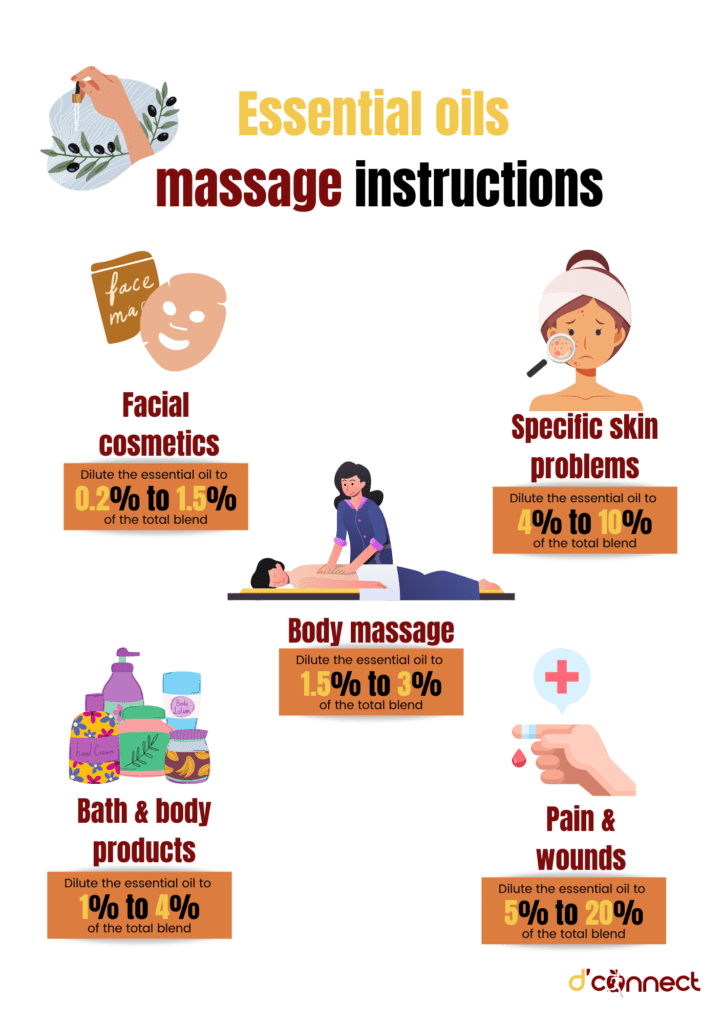
Robert Tisserand’s table recommends topical percentages and dilution guidelines. See below.
Purpose of the essential oil mixture | Dilution range |
Facial cosmetics | 0.2-1.5% |
Body massage | 1.5-3% |
Bath & body products | 1-4% |
Specific problems | 4-10% |
Pain, wounds | 5-20% |
Aromatherapy blends
A good combination for lavender are
- floral essential oils (chamomile, rose, geranium and neroli)
- herbal essential oils (clary sage, lemongrass, marjoram, helichrysum, peppermint and rosemary)
RELATED — Lemongrass (Cymbopogon citratus)
- woody essential (sandalwood, cedarwood, eucalyptus, cypress, and rosewood)
RELATED — Sandalwood (Santalum spicatum)
- citrus oils like grapefruit and orange
- gum oils like myrrh and frankincense
RELATED — Sweet Orange (Citrus Sinensis)
Skin protecting blend (after sun bathing)
Blend well and apply generously on the sun exposed areas.
- Lavender – 2 drops
- Helichrysum / immortelle / everlasting – 2 drops
- Aloe vera gel – 10ml
- Jojoba – 10ml
Healing ointment
This mixture is great for calming insect bites and cooling down burns. It also supports wound healing.
- Lavender – 1 drop
- Manuka (essential oil) – 1 drop
- Rose – 1 drop
- Tea tree – 1 drop
- Carrier (vegetable) oil – 50ml
Anti-inflammatory healing blend
- Lavender – 2 drops
- Melissa – 2 drops
- Tea tree – 2 drops
- Aloe vera gel – 5ml
Room disinfectant solution
This blend is great for the diffuser if you like to clear the room of unwanted pathogens.
- Lavender – 1 drop
- Angelica root – 1 drop
- Fir – 1 drop
- Cedarwood – 1 drop
- Lemon – 1 drop
If you don’t have a diffuser, the blend can be added to a 50 ml spray bottle with distilled water and 10 ml of alcohol, which acts as an emulsifier. Shake well before spraying generously.
Lymphatic flow blend
This combination of essential oils relieves swollen and heavy legs. When applying, massage the legs with upwards movement towards the heart.
- Lavender – 2 drops
- Myrtle – 1 drop
- Juniper berry – 1 drop
- Cypress – 1 drop
- Carrier (vegetable) oil – 10ml
Inhalation blend
- Lavender – 1 drop
- Benzoin – 1 drop
- Melissa – 1 drop
- Ravintsara – 1 drop
- Thyme linalool – 1 drop
Boil 1 litre of water and put it in a bowl. Then add the essential oils and with a towel over your head inhale the steam slowly for 5-15 minutes.
Facial cream for sensitive skin
- Lavender – 4 drops
- Neroli – 4 drops
- Rose – 4 drops
- Lemon – 1 drop
- Frankincense – 1 drop
- Unscented cream base – 50ml
Hair shampoo blend for greasy hair
- Lavender – 10 drops
- Bergamot – 5 drops
- Melissa – 5 drops
- Cedarwood / Lime / Lemon / Cypress – 10 drops
- Unscented shampoo base – 200ml
Hair shampoo blend for dandruff
- Lavender – 8 drops
- Roman chamomile – 3 drops
- Rosemary – 8 drops
- Juniper / eucalyptus / cedar wood – 6 drops
- Unscented shampoo base – 200ml
RELATED — Eucalyptus (Eucalyptus globulus)
Precaution and safety
Low doses of lavender are non-toxic and non-irritant, which makes it one of the safest essential oils around. It is even used as food flavouring.[1]
Lavender is safe to use during pregnancy
Little known facts about lavender
Most lavender sold is actually not true lavender, it is a hybrid known as lavandin.
This hybrid plant is a cross between spike lavender and true lavender, and many growers use it because it produces up to 10 times more essential oil than true lavender.
This is the lavender mostly used for scented candles, soaps, potpourri, or perfume. However, this essential oil has a very different chemical composition than true lavender and has a higher camphor content. This means that we can not expect the same therapeutic benefits.
If you are interested in the medicinal benefits of lavender, I suggest looking for true lavender by checking the label for the correct Latin name.
Related Questions
1. Are there any possible side-effects with using lavender essential oil?
Low doses of lavender are very safe and don’t have any side effects. Higher doses can have an excitable effect instead of calming and relaxing.
2. Can lavender essential oil increase levels of estrogen in men?
Recent studies have shown that lavender in high doses can have estrogen-like effects which lowers the testosterone levels in young boys and men.
3. Does lavender essential oil have any benefits for hair?
Lavender helps with greasy hair and dandruff.
For more information on essential oils, please see our Natural Medicine section.
Angelika has been supporting clients, friends and family members on their journey to health and wellbeing for more than 30 years through healing sessions, education and wellness retreats. After being interested in holistic health care all her life and studying with various Masters in their field in Asia, Germany and Australia, Angelika settled in Auckland 15 years ago where she offers holistic treatments from her studio in Mission Bay.
Her unique and bespoke approach to healing combines ancient techniques such as TCM, Aromatherapy, Colour-Light-Therapy and Reiki with Energy Healing modalities like Kinesiology and BodyTalk.
If you are interested to learn more, please visit Angelique Healing.
References
(1) Hanger, S. (1998). The Aromatherapy Practitioner Reference Manual.
(2) Caddy, R. (1997). Aromatherapy – Essential Oils in Colour.
(3) Mojay, G. (1999). Aromatherapy for healing the spirit. Gaia Books.
(4) Penoel, D. (2000). Life helping life – Unleash your mind/body potential with essential oils. Roger Jollois.
(5) Lillehei AS, Halcón LL, Savik K, Reis R. Effect of Inhaled Lavender and Sleep Hygiene on Self-Reported Sleep Issues: A Randomized Controlled Trial. J Altern Complement Med. 2015 Jul;21(7):430-8. doi: 10.1089/acm.2014.0327. Epub 2015 Jun 2. PMID: 26133206; PMCID: PMC4505755. https://www.ncbi.nlm.nih.gov/pmc/articles/PMC4505755/
(6) Harada H, Kashiwadani H, Kanmura Y, Kuwaki T. Linalool Odor-Induced Anxiolytic Effects in Mice. Front Behav Neurosci. 2018 Oct 23;12:241. doi: 10.3389/fnbeh.2018.00241. PMID: 30405369; PMCID: PMC6206409. https://www.frontiersin.org/articles/10.3389/fnbeh.2018.00241/full
(7) Mori HM, Kawanami H, Kawahata H, Aoki M. Wound healing potential of lavender oil by acceleration of granulation and wound contraction through induction of TGF-β in a rat model. BMC Complement Altern Med. 2016 May 26;16:144. doi: 10.1186/s12906-016-1128-7. PMID: 27229681; PMCID: PMC4880962. https://www.ncbi.nlm.nih.gov/pmc/articles/PMC4880962/
(8) Thompson A, Meah D, Ahmed N, Conniff-Jenkins R, Chileshe E, Phillips CO, Claypole TC, Forman DW, Row PE. Comparison of the antibacterial activity of essential oils and extracts of medicinal and culinary herbs to investigate potential new treatments for irritable bowel syndrome. BMC Complement Altern Med. 2013 Nov 28;13:338. doi: 10.1186/1472-6882-13-338. PMID: 24283351; PMCID: PMC4220539. https://www.ncbi.nlm.nih.gov/pmc/articles/PMC4220539/
(9) Salamati A, Mashouf S, Mojab F. Effect of Inhalation of Lavender Essential Oil on Vital Signs in Open Heart Surgery ICU. Iran J Pharm Res. 2017 Winter;16(1):404-409. PMID: 28496494; PMCID: PMC5423266. https://www.ncbi.nlm.nih.gov/pmc/articles/PMC5423266/
(10) Aboutaleb N, Jamali H, Abolhasani M, Pazoki Toroudi H. Lavender oil (Lavandula angustifolia) attenuates renal ischemia/reperfusion injury in rats through suppression of inflammation, oxidative stress and apoptosis. Biomed Pharmacother. 2019 Feb;110:9-19. doi: 10.1016/j.biopha.2018.11.045. Epub 2018 Nov 16. PMID: 30453254.
(11) Noles, Corey D and Harrod, Kevin S and Tipper, Jennifer L and Waugh, Jonathan B. Effect of Essential Oils on Growth of a Common Respiratory Tract Pathogen. 2018. Respiratory Care

